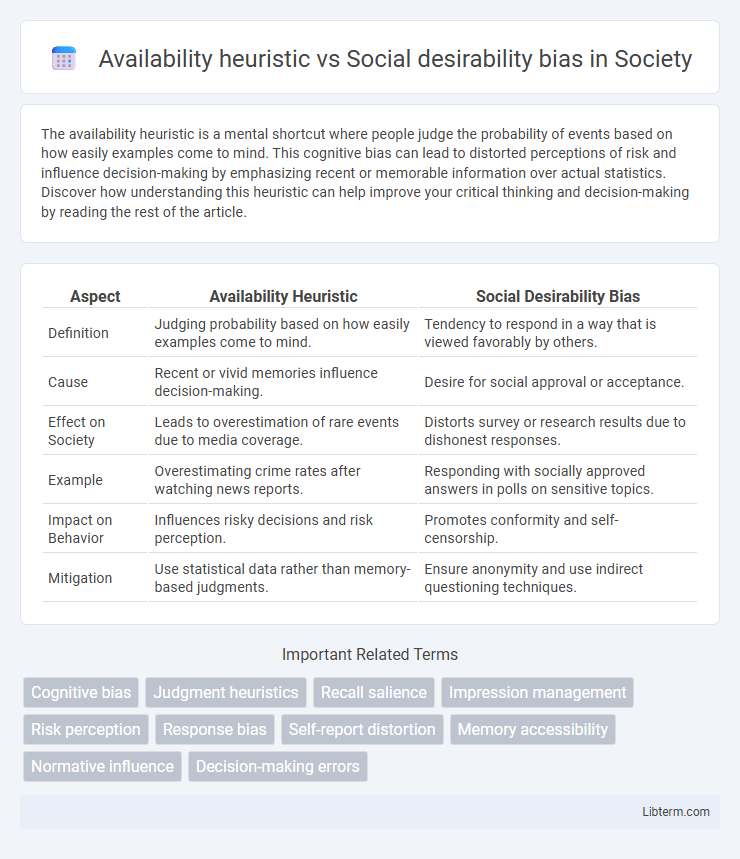The availability heuristic is a mental shortcut where people judge the probability of events based on how easily examples come to mind. This cognitive bias can lead to distorted perceptions of risk and influence decision-making by emphasizing recent or memorable information over actual statistics. Discover how understanding this heuristic can help improve your critical thinking and decision-making by reading the rest of the article.
Table of Comparison
| Aspect | Availability Heuristic | Social Desirability Bias |
|---|---|---|
| Definition | Judging probability based on how easily examples come to mind. | Tendency to respond in a way that is viewed favorably by others. |
| Cause | Recent or vivid memories influence decision-making. | Desire for social approval or acceptance. |
| Effect on Society | Leads to overestimation of rare events due to media coverage. | Distorts survey or research results due to dishonest responses. |
| Example | Overestimating crime rates after watching news reports. | Responding with socially approved answers in polls on sensitive topics. |
| Impact on Behavior | Influences risky decisions and risk perception. | Promotes conformity and self-censorship. |
| Mitigation | Use statistical data rather than memory-based judgments. | Ensure anonymity and use indirect questioning techniques. |
Understanding Cognitive Biases: An Overview
Availability heuristic influences decision-making by relying on immediate examples that come to mind, often causing overestimation of event likelihood based on recent exposure or vivid memories. Social desirability bias impacts responses in surveys or interviews, as individuals tend to present themselves in a favorable light, skewing data accuracy. Understanding these cognitive biases is crucial for improving judgment, communication, and research validity across psychology and behavioral sciences.
Defining the Availability Heuristic
The availability heuristic is a cognitive bias where individuals judge the probability or frequency of an event based on how easily examples come to mind. This mental shortcut leads people to overestimate occurrences of vivid or recent events while underestimating less memorable ones. In contrast, social desirability bias involves individuals altering responses to appear favorable or acceptable within social norms.
What is Social Desirability Bias?
Social desirability bias occurs when individuals respond to questions or behave in ways they believe are socially acceptable or favorable rather than being truthful, often skewing research and survey results. This bias leads to overreporting of positive behaviors and underreporting of negative or unpopular opinions due to fear of judgment or desire for approval. Unlike the availability heuristic, which is a cognitive shortcut based on immediate examples, social desirability bias specifically impacts self-report accuracy by influencing respondents to conform to perceived social norms.
Key Differences Between Availability Heuristic and Social Desirability Bias
The availability heuristic influences decision-making by relying on immediate examples that come to mind, often causing people to overestimate the likelihood of events based on memorable or recent information. In contrast, social desirability bias affects self-reporting and behavior, driving individuals to present themselves in a favorable light to conform to societal norms or expectations. While the availability heuristic distorts judgment through cognitive shortcuts in perception, social desirability bias skews responses due to social pressures and the desire for approval.
Psychological Mechanisms Behind Each Bias
The availability heuristic arises from cognitive processes where individuals judge the likelihood of events based on how easily examples come to mind, often influenced by recent exposure or vividness. Social desirability bias stems from motivational factors, driving individuals to respond in ways that will be viewed favorably by others, leading to distorted self-reporting. These biases operate through distinct psychological pathways: availability heuristic is linked to memory retrieval and representativeness, while social desirability bias involves impression management and self-presentation concerns.
Real-Life Examples of Availability Heuristic
The availability heuristic influences judgments based on readily accessible memories, such as fearing air travel after hearing about a recent plane crash, despite statistics showing flying is safer than driving. In contrast, social desirability bias affects how individuals respond to surveys or interviews, often leading them to overreport socially accepted behaviors like charitable donations or underreport undesirable habits like smoking. Real-life availability heuristic examples include overestimating crime rates after seeing extensive media coverage or assuming shark attacks are common following a high-profile incident, skewing risk perception.
Real-Life Examples of Social Desirability Bias
Social desirability bias often skews survey results as individuals may overreport behaviors like exercising or voting to align with societal norms, unlike the availability heuristic which influences judgments based on memorable instances. For example, in workplace diversity studies, employees might underreport discriminatory attitudes to appear more socially acceptable. This bias also emerges in health surveys where patients understate smoking or alcohol consumption due to fear of judgment.
Impact of These Biases on Decision-Making
The availability heuristic leads individuals to overestimate the importance of information that is most readily recalled, often causing skewed risk assessments and impulsive decisions. Social desirability bias causes people to alter responses or behaviors to conform to perceived social norms, resulting in inaccurate data and compromised honesty in decision-making environments. Both biases distort rational judgment, reducing the effectiveness of choices in business, healthcare, and social contexts.
Strategies to Mitigate Availability Heuristic and Social Desirability Bias
To mitigate the availability heuristic, use systematic data collection and consider multiple perspectives to avoid reliance on easily recalled information. Counter social desirability bias by ensuring anonymous responses, employing indirect questioning techniques, and emphasizing confidentiality to encourage honest answers. Combining these strategies enhances decision-making accuracy and research validity by reducing cognitive and social biases.
Conclusion: Navigating Biases for Better Judgment
Understanding the differences between availability heuristic and social desirability bias enables more accurate decision-making and interpersonal communication. The availability heuristic often leads to overestimating the importance of readily recalled information, while social desirability bias skews responses to align with perceived social norms. Recognizing these biases allows individuals to implement critical thinking strategies, fostering better judgment and reducing distortions in perception and reporting.
Availability heuristic Infographic

 libterm.com
libterm.com